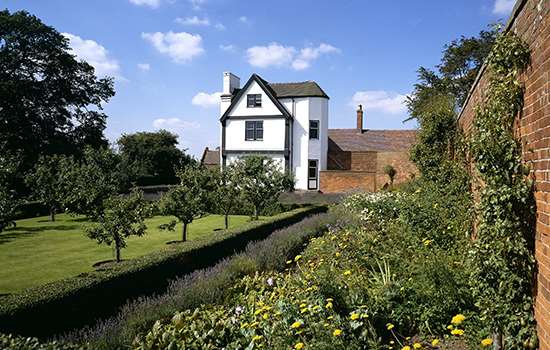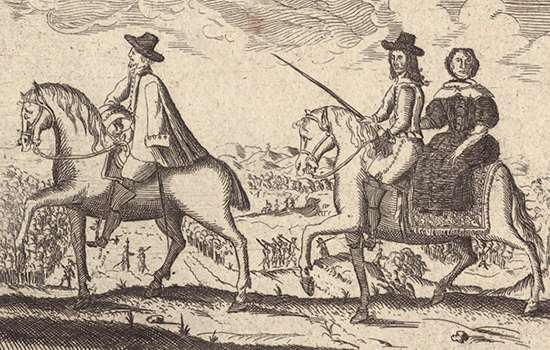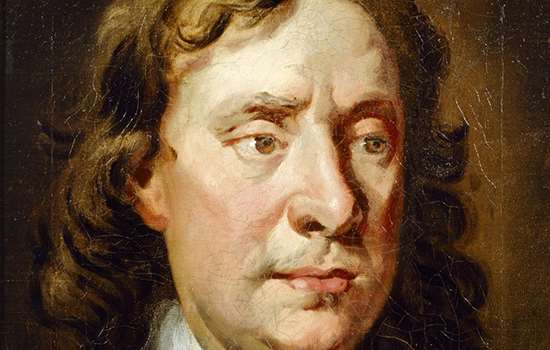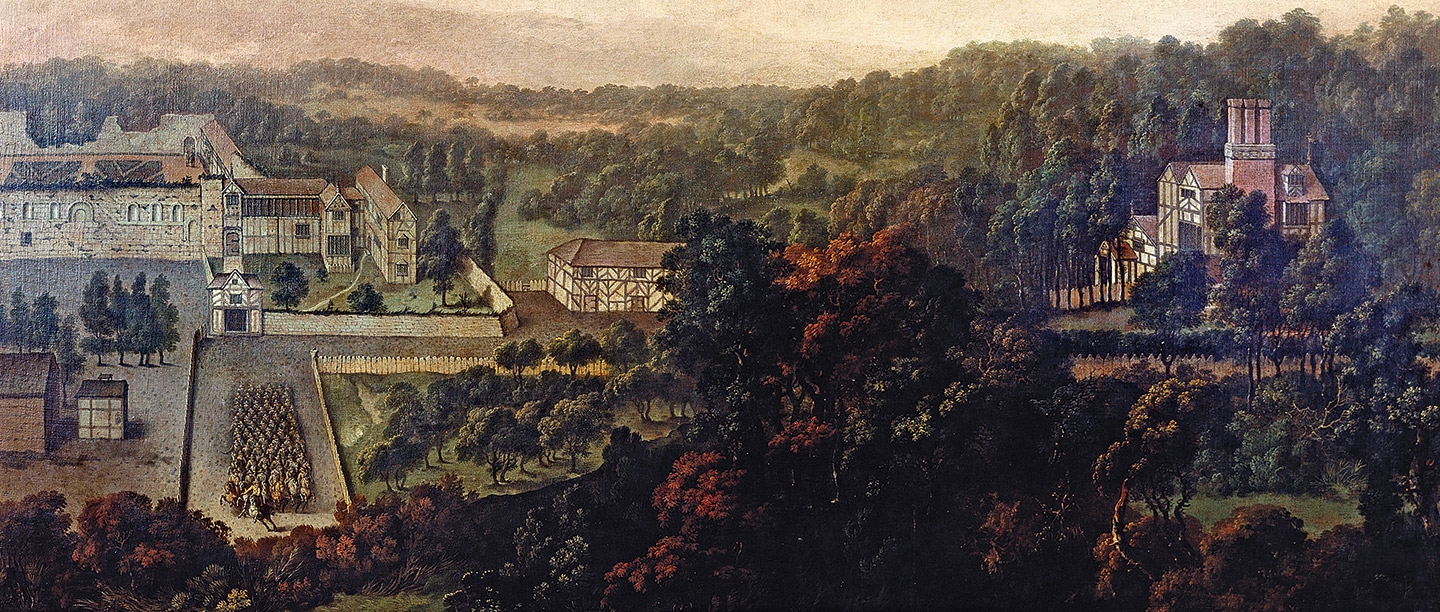‘The Beautiful Wood’
Boscobel House was built as a lodge or secondary residence by John Giffard, a small landowner whose main residence was at White Ladies Priory, about a mile away. The earliest part of Boscobel House has been dated by dendrochronology ̶ tree-ring dating ̶ to about 1595. This was a simple timber-framed cottage with two rooms on two storeys, which now forms part of the north wing of the present house. In about 1624 ̶ 30 John Giffard added a three-storey wing and by 1632 the house was referred to as ‘the house now called or knowne by the name of Boscobel’. The name derives from the Italian words ‘bosco bello’, meaning ‘the beautiful wood’, for at the time the house was surrounded by dense woodland.
The new wing’s main rooms were fitted with panelling and plasterwork, while outside was a garden enclosed with hedges and laid out with formal beds, with a miniature hill or mount with an arbour on top. Boscobel resembled the hunting lodges sometimes built by members of the gentry and nobility, but there is no evidence of hunting having taken place there. John Giffard probably built it as a Catholic retreat and ‘safe house’.
A Catholic ‘Safe House’
The Giffard family had been major landowners in Shropshire and Staffordshire since the 12th century, with their senior branch at Chillington Hall, about 5 miles away. John Giffard’s father, Edward, acquired the estate of White Ladies Priory by marriage to Joan, the widow of William Skeffington, who in turn acquired the lease of the site after the suppression of the priory in 1536. Like many of their neighbours in south Staffordshire, the Giffards remained Catholics after the Reformation in the 16th century, when the Church of England split from the Roman Catholic Church. The Giffards continued to practise their religion quietly, while remaining loyal to the Crown. John Giffard, grandfather of the builder of Boscobel, entertained Elizabeth I at Chillington in 1575, but was denounced as a Catholic and spent much of the rest of his life in prison or on parole.
Catholic families like the Giffards, known as recusants, were barred from roles in public life and suffered heavy fines. Catholic priests and religious services were outlawed, so Catholic families had to hold services in secret. A priest found by the authorities would have been imprisoned, and possibly executed, so Catholic families made hiding places or ‘priest holes’ in their houses in case they were searched. Boscobel has two ‘priest holes’, one under the closet which opens off the Squire’s Room, and another under the stairs which lead to the attic gallery. When Charles II was fleeing after the Battle of Worcester, the Earl of Derby advised him to take refuge with the Giffards because as recusants they were ‘most like to have the readiest means and safest contrivances to preserve him’, and so it proved.
Charles II and the Battle of Worcester
After Charles I’s defeat in the first Civil War, and his execution in January 1649, his son was recognised by Royalists as King Charles II. Charles returned to Scotland from exile in 1650 to rally support for his cause in Scotland and the North of England. He raised an army of supporters, but was defeated by superior Parliamentarian forces at the Battle of Worcester on 3 September 1651.
Charles escaped northwards after the battle with several hundred supporters. Realising that the group was too small to prevail in battle, but too big to avoid detection, the king and a smaller group broke away. Companions suggested that the Giffards’ houses at White Ladies and Boscobel be used as hiding places. John Giffard had died, and his widow Dorothy was living at White Ladies, though the estate had passed to their daughter Frances Cotton. The family’s Catholicism made them strong supporters of the Royalist cause. Their houses and estate were looked after by the five Penderel brothers, tenant farmers and servants, who likewise were Catholics and Royalists.
Charles arrived at White Ladies House on the morning of 4 September. He parted from his remaining followers, and disguised himself as a countryman, with the Penderels’ help. Richard Penderel guided Charles in an abortive attempt to get to Wales on foot. This was frustrated when they found that the crossings of the river Severn were guarded. Charles and Richard headed back east, arriving at Boscobel House at about dawn on 6 September.
Charles at Boscobel
Charles was welcomed to Boscobel by another of the Penderel brothers, William, and his wife Joan, who looked after the house for the Giffards. Charles had walked for miles and hardly slept for two nights, and was tired and dirty. He ate a meal and had his shoes dried. However, he was not safe, for Parliamentarian soldiers were in the area. Charles and Major William Careless, a soldier from his army who had also taken refuge at Boscobel, hid in an oak tree in the wood to the south of the house. It was possible to hide in it because the oak had been pollarded: its branches had been cut off near the trunk so they would grow back more densely. The two men remained in the tree all day, and saw soldiers searching the wood below. In the evening, they returned to the house. That night, Charles hid in the priest hole under the attic stairs, in case the Parliamentarians returned. On the following day, he rested in the garden until nightfall, when all five Penderel brothers escorted him eastwards to Moseley Old Hall, for the next stage of his journey. Disguised this time as the servant of a local Royalist gentlewoman, Jane Lane, Charles eventually made his way to Shoreham-on-Sea in Sussex, where he was taken by a merchant ship to Rouen, and then to Paris.
The Commonwealth regime declined after the death of Oliver Cromwell in 1658, and Charles II was restored to the throne on 29 May 1660. The story of his escape and the Boscobel Oak became public knowledge, and 29 May became known as Oak Apple Day. The Penderels, Jane Lane and other people who had helped Charles to hide and escape were rewarded with pensions. Pensions are still being paid to the Penderel descendants today, administered by the Giffard family of Chillington.
Read more about Charles II’s dramatic escapeBoscobel in the 19th century
In 1812 the Fitzherbert family sold the Boscobel and White Ladies estate, measuring 659 acres (267 hectares), to Walter Evans (1764 ̶ 1839), a wealthy industrialist from Derby, for £48,000. Walter bought the estate for his two nieces Elizabeth (1786 ̶ 1882) and Frances (1789 ̶ 1873): they were also his stepdaughters, for Walter had married their mother, his brother William’s widow Elizabeth.
Frances and Elizabeth did not marry, and lived together at Darley Abbey, outside Derby, near the family’s mills. Each summer they made long visits to Boscobel, where they re-established a garden based on 17th-century historic views, and refurnished the house in a Romantic antiquarian style, to evoke its appearance at the time of Charles II’s visit. The sisters organised ‘Dame Schools’ in the area, to provide poor local children with a free primary education. When Frances Evans died her share of the estate passed to Elizabeth, who continued to visit Boscobel in her eighties.
The Evans Family and their Fortune
The Evans family first made their fortune from mining and smelting iron, lead and copper in Derbyshire in the early 18th century. Thomas Evans (1723 ̶ 1814) was one of the first businessmen to develop cotton-spinning mills using the water-powered technology invented by Richard Arkwright. Evans bought land at Darley Abbey in 1778, where he established a spinning mill in partnership with Arkwright’s associate Jedediah Strutt. His son William had died in 1796, so Thomas was succeeded by his second son, Walter Evans. The family businesses expanded to embrace cotton spinning, paper manufacturing, and a bank, Evans & Crompton. By the standards of the age, the Evans businesses were benevolent employers, providing schooling for their employees’ children, some of whom probably also worked in their mills.
In the late 18th century, the Evans family’s mills probably spun cotton grown on plantations worked by enslaved people in Brazil and the Caribbean. The next generation of the family, however, were strongly opposed to slavery: Frances and Elizabeth’s brother William Evans (1785 ̶ 1856), a Whig MP, was a prominent member of the campaign to abolish it, which succeeded in 1833 with the Abolition of Slavery Act.
Boscobel in Modern Times
In 1913 Elizabeth Evans’s heirs put the Boscobel and White Ladies estate up for sale. In 1918 it was bought by the Earl of Bradford, a major landowner who lived at nearby Weston Park. Sadly, the contents assembled by the Evans sisters were sold. The house and the Royal Oak remained open to visitors, though the rooms were mostly left bare. In 1954 Lord Bradford placed the house in the Ministry of Work’s guardianship. In 1967 the farm at Boscobel was closed, and the rest of the farm buildings were transferred to the Ministry. Some of the buildings were demolished, including the house’s brewhouse and kitchen.
The house was transferred to English Heritage’s care when it was set up in 1984. Since then, it has been refurnished to re-create its appearance in the 19th century. In 2020 English Heritage acquired a lease of the Royal Oak Field and planted it with oak saplings, which will grow up to provide a woodland setting for the Royal Oak and the house, more in keeping with their historic appearance.
Boscobel Farm
The 659-acre (267 hectares) estate bought by Walter Evans in 1814 was divided into two large farms, Boscobel and White Ladies. In the early 19th century they were mixed farms, growing arable crops as well as farming sheep, cows and pigs. In the later 19th century arable farming went into decline because of Free Trade legislation, which resulted in a lack of protection for British farming, and competition from cheaper grain imported from the American Mid-West.
Like many other estates, Boscobel was adapted to function primarily as a dairy farm, raising cows to produce milk, butter and cheese for the domestic, urban market. One early farm building, a timber-framed barn probably dating from the 17th century, survives. The other farm buildings are all of red brick and date from the 19th century. The buildings include a cart-shed, a bull-pen, a smithy, cattle-sheds and a feed-store, and a hackney stable for carriage horses. Another group of brick barns was built across the road from the farmyard, probably to house cattle. This is now outside English Heritage’s ownership and has been converted as a private house. The farm buildings at Boscobel have now been adapted to serve the current needs of the site, but they remain a good example of a 19th-century farm.
Further Reading
T Blount, Boscobel, or The History of King Charles’s Most Miraculous Preservation after the Battle of Worcester (London, 1660)
W Matthews (ed), Charles II’s Escape from Worcester: A Collection of narratives assembled by Samuel Pepys (London, 1967)
R Sherwood, The Civil War in the Midlands, 1642–1651 (Stroud, 1992)
P Stamper, ‘The tree that hid a king: the Royal Oak at Boscobel, Shropshire’, Landscapes, 3:1 (2002), 19–34
G Wrottesley, ‘The Giffard family from the Conquest to the present time’, Collections for a History of Staffordshire: New Series, Volume 5 (1902)
Explore more
-

Visit Boscobel
Explore the beautiful orchard and gardens, see the descendant of the famous Royal Oak, and hunt out Charles II’s hiding place inside Boscobel House.
-

Charles II and the Royal Oak
Find out how the future king escaped from Parliamentarian forces during the Civil War in 1651, giving English history one of its greatest adventure stories.
-

History of White Ladies Priory
Read more about Boscobel’s sister site, where Charles II first arrived after his flight from the battle of Worcester.
-

The Civil War
Learn more about the Stuarts, the Civil War and Oliver Cromwell’s rule after the execution of Charles I in 1649.

